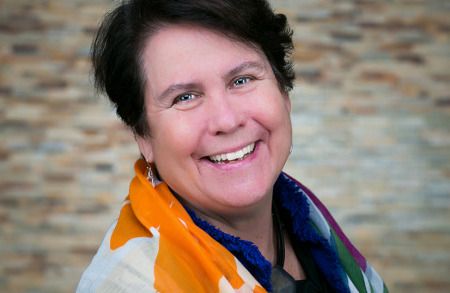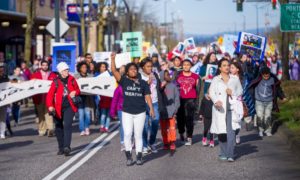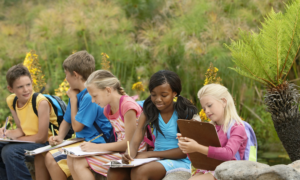
Pixabay
.
Alicia Philipp has led the Community Foundation of Greater Atlanta for almost 40 years and will retire in early 2020. She spoke with Youth Today reporter Stell Simonton about the ways in which the foundation benefits young people.
The Conversation
Stell Simonton: The Community Foundation of Greater Atlanta serves a large metro area of 23 counties. It works in several areas: health, education, the arts. But what about the work to support children and youth: Did that start at a particular time?
Alicia Philipp: No, children and youth are always, always the focus. If you’re going to create a community that has opportunities for all, you really have to be about access and quality of services and everything for children and youth as well.
Simonton: I know that one of the things you have is a program called Achieve Atlanta. Can you tell me a little bit about it, how it supports students and also how you measure the impact of it?
Achieve Atlanta
Philipp: Achieve Atlanta is what is termed a supporting organization of the Community Foundation. It has a separate board and a separate staff. But it is part of us. … The problem was that only 14% of students from the Atlanta Public School system were earning a post-secondary degree of any kind within six years of high school graduation. That’s just not acceptable when 60% of jobs are going to require some sort of a degree.

Alicia Philipp
We spent a year looking all around the country at other successful ways of changing that trajectory. How do you change that 14%? How do you raise that? It really becomes about how you prepare kids to go to college. And how do you support them when they’re in college so that they can be successful.
The Achieve Atlanta program is really about those things — not the stuff they’re learning in school, but the preparation for the next step. So it’s about how many of them are completing the FAFSA. How many are taking the SAT and the ACT? How many are enrolling in college? And then it’s providing scholarships to every kid that needs one.
Simonton: So it supports kids in getting prepared for college as well as actually helping pay for it.
Philipp: Prepared and then to go [to college] with the scholarship support. Through 2018, 2,200 Atlanta public school graduates have received over $11 million to go to college. So it’s not only getting them ready, it’s about helping them to actualize that dream. And it’s providing support for them while they’re in college.
Some of that is done [via electronic communications] if the kids are away. But in colleges where there’s a large cohort of students, there’s actually a person on campus that works with them who’s part of the university. [That coach] is assigned to Achieve Atlanta scholars to really nurture them and to help them so that they can succeed.
[Achieve Atlanta] started in 2016. So we’re going to be coming soon to the ability to see what the four-year graduation rate is. We don’t know that particular result [yet] … But the number of kids completing the FAFSA has increased from 51% to 71%. The enrollments increased from 53% to 62%. So those are good indicators.
How one giving circle is created
Simonton: I also wanted to ask you about the Lorde-Rustin Giving Circle. I wondered how it got its name and what it does.
Philipp: Giving circles are fairly common in community foundations as ways for people of like minds to come together to pool their resources and make gifts that not any of them could have done by themselves. And to be in the process of learning, because they’re supported by the staff of the community foundation, whose job is to know what’s happening in the community and what organizations are strong. …
So this group of people had come together and then they’re like, “Whoa! The community foundation can really help us.” [The foundation gave them] background information about CHRIS 180 [which provides housing and other services for youth] and about Create Your Dreams [which helps low-income kids pursue education and other goals]. These weren’t organizations that the Giving Circle members knew. … Listening to what the members of the circle wanted to accomplish, we helped bring groups to them that could hit their sweet spot.
Simonton: I gather they were inspired by the work of Audre Lorde [a poet and African-American lesbian feminist activist] and Bayard Rustin [a leader in civil rights, gay rights and nonviolence].
Philipp: Yes, and they are predominantly an African-American gay and lesbian group.
Simonton: And CHRIS 180 is one of the organizations they are serving …
Philipp: CHRIS 180 was one of their grantees and the grant was particularly for LGBTQ youth of color.
Simonton: Let me ask you about an event the Community Foundation sponsored in 2015. You brought Robert Putnam, the Harvard political scientist and author of “Our Kids: The American Dream in Crisis” to speak here. His book argues that social and economic changes in the country have reduced opportunities for kids. Did his visit spark any particular action here?
Philipp: Big time! You know, we probably had well over 100 donors who went to it. About 30 of them approached us afterwards and said: We want to do more. … So we created a group once again. It wasn’t a giving circle at that time. It was just a learning group of these donors.
Our staff really prepared a yearlong learning journey where [the donors] saw how the inequity of opportunity in Atlanta affected health, affected education, affected affordable housing. They did a lot of site visits. …They bonded with each other. … [They asked] where could we really make a difference? And so we did research.
There is a census tract in Atlanta that is the worst in all kinds of measures. It’s the least economically viable census tract. And we said, let’s work there. So they began making grants to fairly traditional nonprofit organizations that were beginning to work in this area. But what’s so heartening is that most recently they have begun doing participatory grantmaking where they give the money to the community to give away. Talk about sharing power! It’s just the ultimate.
Simonton: And that is which community?
Philipp: It’s called Thomasville Heights. … We hired a community organizer to work with us. We had a very simple process for [community members] to volunteer to serve [on] the resident committee. And the resident committee had seven people on it from age 16 to 80. It’s just fabulous that we’re hearing youth voice as well as adult voice. And then residents of the community put forward proposals for what they would like to get money to do. And the resident committee then allocated that money.
Simonton: That sounds really interesting.
Philipp: Isn’t that cool?
Simonton: Yes. And intergenerational.
Philipp: Yes, very much so.
Not just grants
Simonton: I know also that the Community Foundation has done work to strengthen nonprofits.
Philipp: Way back in the ’80s, we began to realize that we could make grants till the cows come home. But we weren’t having the impact we needed because nonprofits needed so much more than just money. They needed all kinds of help around strategic planning, around volunteer management, around governance, around budgeting. There were lots of professional development needs …
The Community Foundation created the Nonprofit Resource Center. … After 13 years, we spun it off into its own organization called the Georgia Center for Nonprofits. …
We also do a number of other things. We provide grants for nonprofits to be able to get consultants … to get the help to do strategic planning or succession planning.
We’re working now very closely with Catchafire, which is an amazing organization. It has a platform so that nonprofits can be connected to talent anywhere in the country where a volunteer has signed up. [These volunteers can] do a lot of nonprofit projects, marketing brochures and other things.
In the first 13 months, nonprofits saved $1.3 million by using the Catchafire platform … It’s a way to bring volunteers and nonprofits together to strengthen nonprofits.
Simonton: I also wanted to ask you about GoATL. It’s a social impact fund. And I wondered what its focus was.
Philipp: The focus is on exactly the same things that the Community Foundation is focused on. But what it’s using is the power of our assets rather than our grants.
We did a whole year’s worth of research … and looked around the country at other social impact funds. We took $10 million from our assets and we’re investing in low-interest long-term loans to really be able to move things ahead faster in areas of affordable housing, more quality seats in daycare centers, some charter schools and arts organization. … It really begins to make more capital available in our areas of focus to organizations that are trying to take that next leap forward. …
Simonton: Social impact funds: It’s my understanding they’re a relatively new approach. What makes them popular or of interest to folks?
Philipp: One of the things that holds the nonprofit sector back is that they survive solely by philanthropy or government grants. They’re not able to borrow money usually. … So for an affordable housing organization to be able to go in and buy up 10 houses to fix up and resell them to low-income people — how do they do that? Where do they get that money? It’s not all going to be able to come from philanthropy, from charitable contributions. This way they can borrow it, pay it back, borrow it again. …
Simonton: Is there anything we haven’t touched on about the work of the Community Foundation of Greater Atlanta that you want to add?
Philipp: Well, the one thing I would add is … we really are going deeply into the equity of opportunity. We’re looking at [cultivating] prosperous people, strong families, thriving communities … We are very focused on making sure that the youngest children get started well. We’re making sure we’re really focused on access to education and higher education. … We’re looking at how we strengthen families to be able to nurture children. So we’re definitely in your wheelhouse in continuing a strong advocacy for children and youth.































